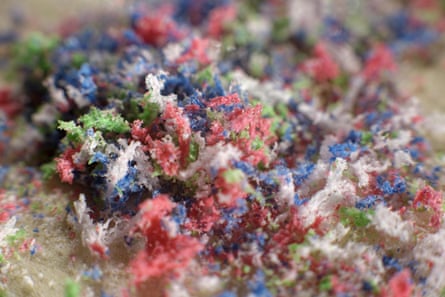
You might not know it, but installing a washing machine filter might be one of the simplest defences against microplastics entering the ocean.
Scientists estimate there are 14m tonnes of microplastic on the ocean floor, and a further 24tn grains floating on the surface of the ocean. Microplastics come from many sources – they can shed from clothes, sneakers and bags made from synthetic materials; or they can be the product of larger pieces of plastic breaking down into smaller and smaller particles.
But 35% of microplastic pollution in the ocean is thought to come from the turbulence and friction of putting our clothes, sheets and towels through the washing machine, which release microfibres – a subcategory of microplastics.
A white paper delivered to the European Commission last month argues that washing machine filters are the only effective near-term solution to reducing the release of microfibres into the environment and should be mandated (the technology exists but inbuilt filters are extremely scarce). The white paper was co-authored by A Plastic Planet and 5 Gyres Institute with three washing machine filter manufacturers, Matter, PlanetCare and Xeros Technology.
Christian Cullinane from Xeros Technology says washing machine filters are capable of preventing “more than 90%” of microfibres in our laundry from entering the water.
Historically there have been questions raised about the effectiveness of filters, with studies rating their effectiveness from as low as 29% to as high as 74%. But other solutions –such as developments in fabric technology to prevent shedding, or catching the fibres at wastewater treatment plants (when an estimated 80% of all wastewater is released without being treated) – are not immediately viable, making filters a good option for now.
In Australia, as part of the national plastics plan, the federal government has proposed a “phase-in” of microfibre filters in new commercial and residential washing machines by 2030.
In the meantime, it is possible to retrofit your washing machine with a microfibre filter – if you have the money to spare. Here experts explain how to do this.
What is a retrofitted washing machine filter?
A retrofit filter is an external filter system that connects to the outlet hose of your washing machine. It captures the microfibres that are released from your laundry before they go down the drain. According to Dr Andrej Kržan, a co-founder of Planet Care, their filters are so fine they catch “all sorts of stuff. Pet hair, you get grass. Some people have small kids so you get sparkles in there too.”
There are several options on the market that range from about $100 to more than $300 and can be ordered online from websites such as Planet Care, Gulp (pre-order only) and Filtrol.
Is a microfibre filter right for your household?
The filters can be quite bulky, so you will need to consider the available space in your laundry before deciding which type to buy one. Some filters can be mounted to the side of the machine or on a nearby wall, so if your machine is tucked neatly into a cupboard, this might not be possible. Others – like the Gulp filter – can sit on top or beside the machine, but need to be plugged into a powerpoint.
after newsletter promotion
And since the filter will need to be emptied or replaced every 20 or so washes (this varies, depending on the brand), you will need to install it somewhere that is easily accessible.
How to dispose of the microfibres
It is essential to properly dispose of the microfibres and other materials that are caught in the filter. The disposal process varies depending on the product.
Fibres captured in the Gulp filter can be brushed into the bin, while PlanetCare uses a swap-and-replace system, where users remove the filter cartridge and post it back to the company. The company cleans the cartridge and sends a new one to the user.
Xeros’ XFilter – which is designed to be installed by washing machine manufacturers, and is not yet commercially available – should be removed and emptied over a bin, according to Cullinane. “It’s very simple, but it’s not a horrible sludge that the customer’s tempted to run under a tap or do anything like which would completely subvert the use.”
Some companies are working on solutions to recycle the particles but these are in their early development stage. According to PlanetCare, the fibres will be turned into insulation mats. Matter, the company that makes the Gulp filter, is trialling a system where the user returns the microfibres with the intention they will be recycled into hard and soft plastic.
When you can’t install a filter …
If you don’t have the space to install an external microfibre filter, another way to reduce microfibre pollution is by using a Guppyfriend bag. Place your polyester or synthetic garments inside a bag before placing it in your washing machine. The bag catches any microfibres that may break off during the laundry cycle.



